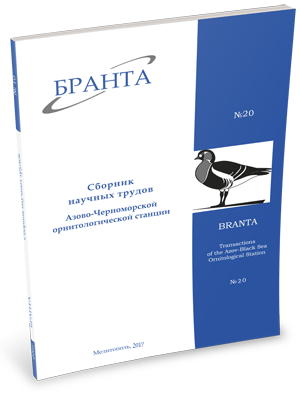
Transactions
of the Azov-Black Sea Ornithological Station



Male and female Black terns choose different prey types for chick provisioning
J. Winden, M. Poot
Eurasian Black terns feed on invertebrates and small vertebrates. Prey types and delivery rates to the chicks have been studied in 1995-2005 in three different habitats in the Netherlands: agricultural grasslands, marshes and moors. Prey items were registered in species groups such as fish, dragonflies, small insects, water beetle larvae and lumbricids. It turned out that the terns took different prey items among different habitats. Fish, beetle larvae and dragonflies were most important from a biomass perspective. Males bring more fish and beetle larvae than females resulting in an average higher biomass delivery rate (9.5 mg/min to 5.5 mg/min) despite it takes more time to catch fish. This again results in a total higher biomass transport to the chicks. As males have larger bills, they might be better fishers while the females might like to stay closer to the nest and thus making shorter flights catching abundant smaller prey.
Read the paper in a PDF fileReferences:
- Antczak J., A. Sikora, Z. Kajzer, P. Zielinski 2015. Distribution and numbers in breeding populations of gulls and terns Laridae in Pomerania. Ptaki Pomorza 5: 5-31
- Birdlife International 2017. http://datazone.birdlife.org/species/factsheet/black-tern-chlidonias-niger (October 2017)
- Borodulina T.L. 1960. Biology and economic importance of gulls and terns of southern - USSR water bodies. Academy of Sciences of the USSR Transactions of the Institute of animal morphology. Translated from Russian, Israel program for scientific translations, Jerusalem.
- Clopper, C. J. & Pearson, E. S. 1934. The use of confidence or fiducial limits illustrated in the case of the binomial. Biometrika, 26, 404-413. https://doi.org/10.1093/biomet/26.4.404
- Cramp S. 1985. Handbook of the birds Europe, the Middle East and North Africa: the birds of the western Palearctic. Vol. 4 . Terns to woodpeckers. Oxford University press, Oxford, UK.
- Gwiazda R. & Ledwon M. 2016. Sex-specific food choices in Whiskered Terns Chlidonias hybrida during chick rearing. Ardea 104: 95-98. https://doi.org/10.5253/arde.v104i1.a8
- Patefield, W. M. 1981. Algorithm AS159. An efficient method of generating r x c tables with given row and column totals. Applied Statistics 30, 91-97. https://doi.org/10.2307/2346669
- R Core Team 2017. R: A language and environment for statistical computing. R Foundation for Statistical Computing, Vienna, Austria. URL https://www.R-project.org/.
- Van der Winden J. 2002. Disturbance as an important factor in the decline of Black Terns Chlidonias niger in The Netherlands. Vogelwelt 123: 33-40.
- Van der Winden J. 2005a. Black Tern Chlidonias niger conservation in The Netherlands - a review. Vogelwelt 126: 187- 193.
- Van der Winden J. 2005b. Fish and amphibians as calcium source for Black Terns Chlidonias niger feeding in acid bogs. Vogelwelt 126: 235-241.